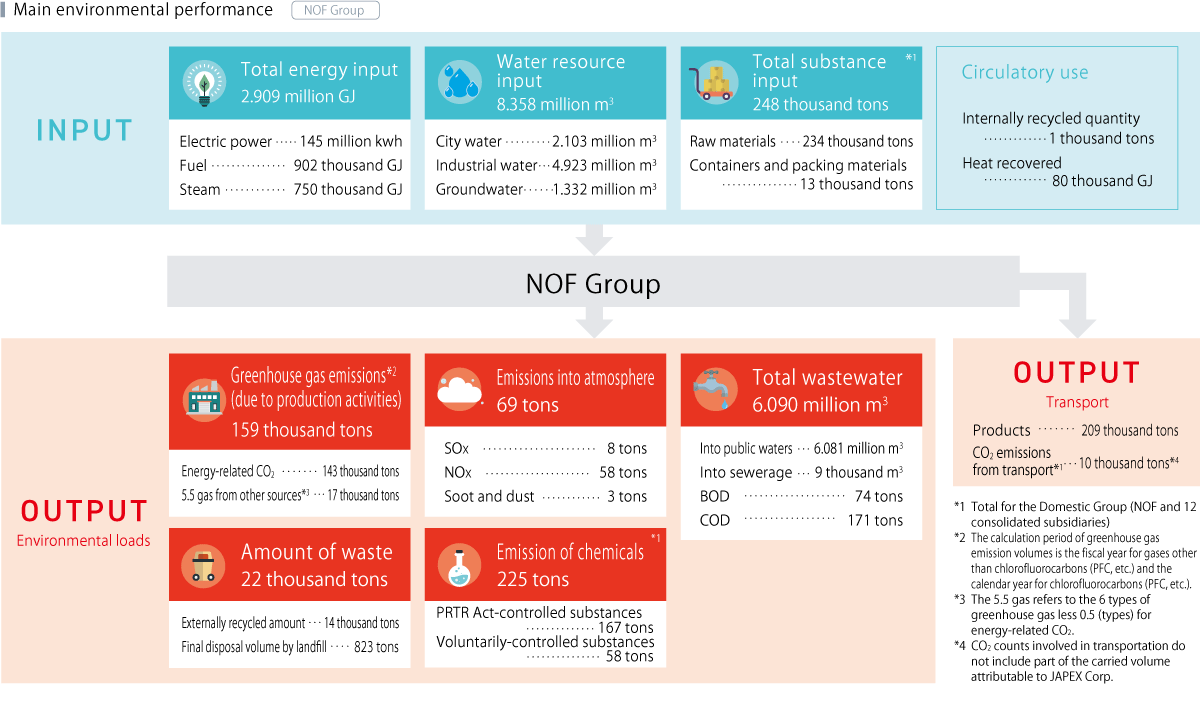Environmental accounting
- TOP
- Sustainability
- Environment
- Environmental accounting
Mass Balance/Environmental Accounting
Main environmental performance factors(NOF Group)
The standing of environmental loads ensuing from business activities by the NOF Group in fiscal 2023 is shown below.

(Click to enlarge)
Environmental accounting
The environmental accounting*1 of the Domestic Group in fiscal 2022 is stated below. The period covered is from April 1, 2023 through March 31, 2024.
| Category | Major activities | Investment | Expenses | |
|---|---|---|---|---|
| (1)Business area expenses | -1 Pollution prevention | Enhancement of wastewater treatment facilities, enhancement of air pollution control facilities | 357 | 1,060 |
| -2 Global environmental protection | Upgrade to energy-saving facilities, replacement of fluorescent lamps to LED | 559 | 161 | |
| -3 Resource recycling | Waste heat recovery equipment, waste disposal costs | 27 | 940 | |
| (2)Upstream/downstream expenses | Reduction in containers and packaging materials | 8 | 2 | |
| (3)Management activity expenses | Environmental audits/improvements/personnel | 1 | 465 | |
| (4)R&D expenses | R&D to curb environmental impact | 0 | 497 | |
| (5)Community activity expenses | Support for regional environmental activities | 0 | 10 | |
| (6)Environmental damage response expenses | - | 0 | 0 | |
| Total *2 | 952 | 3,135 | ||
| Benefit item | Item | FY2023 | vs FY2022 |
|---|---|---|---|
| (1)Benefit from resources used in business activities | Total energy input (thousand GJ) | 2,907 | ▲203 |
| Total substance input (thousand tons) |
248 | 12 | |
| Water resource input (thousand m3) |
8,358 | ▲140 | |
| (2Benefit from environmental impact and waste materials of business sites | Gas emissions (thousand tons of CO2) Production activities: Energy-related Production activities: Others Transportation-related |
169 143 17 10 |
▲16 ▲6 ▲10 - |
| PRTR chemical releases (tons) | 167 | ▲24 | |
| Plant emission volumes (tons) | 22,541 | ▲2,616 | |
| Final disposal of waste by landfill (tons) | 617 | ▲478 | |
| Waste water volumes (thousand m3) |
6,090 | ▲331 | |
| COD emission volumes (tons) | 171 | 23 | |
| NOx emission volumes (tons) | 58 | 3 | |
| SOx emission volumes (tons) | 8 | 1 |
| Category | Particulars of effects | Sum |
|---|---|---|
| (1)Profits | Business income from recycling of wastes from main business or recycling of used products, etc. | 281 |
| Other business income | 0 | |
| (2)Costs saved | Reduction in energy cost by energy saving | 25 |
| Reduction in waste disposal ensuing from materials saving or recycling | 18 | |
| Other reductions | 15 | |
| Total *2 | 339 | |
| Category | Item | FY 2019 |
FY 2020 |
FY 2021 |
FY 2022 |
FY 2023 |
|---|---|---|---|---|---|---|
| Environmental Expenses Domestic Group |
Investment (million yen) |
686 | 1,203 | 1,300 | 1,140 | 952 |
| Expenses (million yen) |
2,657 | 3,136 | 3,155 | 3,448 | 3,135 | |
| Resource volumes used in business activities NOF Group |
Total energy input (thousand GJ) |
3,330 | 3,247 | 3,377 | 3,112 | 2,909 |
| Total substance input (thousand tons) |
253 | 231 | 261 | 236 | 248 | |
| Water resource input (thousand m3) |
8,232 | 8,319 | 8,420 | 8,498 | 8,358 | |
| Environmental loads ensuing from business activities NOF Group |
Greenhouse gas emissions (thousand tons of CO2) Production activities Energy-related Others Transportation- related |
205 173 23 9 |
195 167 20 8 |
198 172 18 9 |
185 149 27 10 |
169 143 17 10 |
| PRTR chemical releases (tons) | 158 | 147 | 155 | 143 | 167 | |
| Plant emission volumes (tons) | 28,446 | 28,955 | 29,164 | 25,157 | 22,541 | |
| Waste sent to landfills (tons) | 1,302 | 1,588 | 950 | 1,095 | 617 | |
| Waste water volumes (thousand m3) | 6,424 | 6,552 | 6,642 | 6,421 | 6,090 | |
| COD emission volumes (tons) | 441 | 219 | 154 | 148 | 171 | |
| NOx emission volumes (tons) | 55 | 57 | 55 | 55 | 58 | |
| SOx emission volumes (tons) | 6 | 4 | 5 | 7 | 8 |
*1:In business activities, Environmental Accounting is a procedure necessary for communicating quantitatively the results based on costs and effect for the environmental conservation activities by the monetary unit or material quantity, the purpose of which is to promote efficiently and effectively the environment conservation, keeping the good relationship with the society.
*2:Rounding of fractions may sometimes make the total inconsistent with individual figures.


